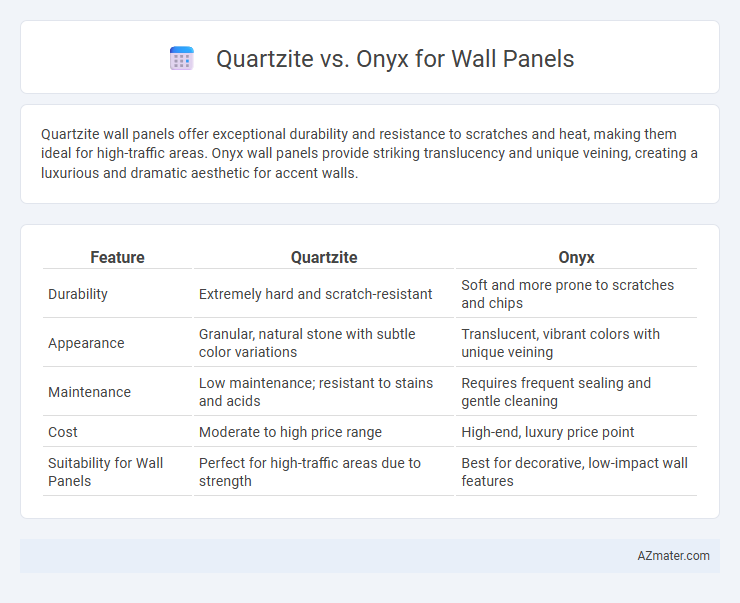Quartzite wall panels offer exceptional durability and resistance to scratches and heat, making them ideal for high-traffic areas. Onyx wall panels provide striking translucency and unique veining, creating a luxurious and dramatic aesthetic for accent walls.
Table of Comparison
| Feature | Quartzite | Onyx |
|---|---|---|
| Durability | Extremely hard and scratch-resistant | Soft and more prone to scratches and chips |
| Appearance | Granular, natural stone with subtle color variations | Translucent, vibrant colors with unique veining |
| Maintenance | Low maintenance; resistant to stains and acids | Requires frequent sealing and gentle cleaning |
| Cost | Moderate to high price range | High-end, luxury price point |
| Suitability for Wall Panels | Perfect for high-traffic areas due to strength | Best for decorative, low-impact wall features |
Introduction: Comparing Quartzite and Onyx Wall Panels
Quartzite wall panels offer superior durability and resistance to heat and scratches, making them ideal for high-traffic areas and kitchens. Onyx wall panels, prized for their translucent beauty and unique veining, create luxurious backlit installations that enhance aesthetic appeal. While quartzite excels in strength and longevity, onyx provides a striking visual impact, influencing the choice based on functional needs and design preferences.
Material Composition and Formation
Quartzite, a metamorphic rock primarily composed of quartz grains fused together under intense heat and pressure, offers exceptional hardness and durability for wall panels. Onyx, a form of banded chalcedony made up of calcite or aragonite crystals, forms through the deposition of calcium carbonate in cold water environments, resulting in translucent and visually striking layers. The mineral composition and formation processes of quartzite and onyx directly influence their structural properties, with quartzite providing superior strength and onyx delivering unique aesthetic patterns.
Visual Appeal and Aesthetic Differences
Quartzite wall panels offer a natural, stone-like appearance with subtle veining and a range of earthy tones, providing a durable and elegant aesthetic suitable for both modern and rustic interiors. Onyx wall panels feature a translucent quality with dramatic, swirling patterns and vibrant color variations, often illuminated to enhance their visual impact, making them ideal for luxurious and striking design statements. The primary visual difference lies in quartzite's more subdued, textured look compared to onyx's glossy, luminous appearance that adds depth and sophistication to any space.
Durability and Strength Comparison
Quartzite offers exceptional durability and superior resistance to scratches, heat, and impact, making it an ideal choice for wall panels in high-traffic areas. Onyx, while visually stunning with its translucent and unique veining, is comparatively softer and more prone to scratches and chips, requiring careful maintenance. For long-term strength and minimal wear, quartzite wall panels outperform onyx in terms of resilience and structural integrity.
Maintenance and Cleaning Requirements
Quartzite wall panels require minimal maintenance due to their natural hardness and resistance to scratches, stains, and heat, making them ideal for high-traffic areas. Onyx panels, though visually stunning with their translucent and unique veining, demand more careful cleaning using mild, pH-neutral cleaners to avoid etching and damage from acidic or abrasive substances. Regular sealing of both materials enhances durability, but quartzite's robustness results in less frequent sealing compared to the more delicate onyx surface.
Cost Comparison: Quartzite vs Onyx
Quartzite wall panels typically cost between $70 to $150 per square foot, reflecting their durability and wide availability. Onyx panels are more expensive, with prices ranging from $100 to $250 per square foot due to their rarity and translucent qualities. Budget considerations favor quartzite for cost-effective yet resilient wall surfaces, while onyx suits high-end installations with its luxurious appearance.
Installation Process and Considerations
Quartzite offers a more straightforward installation process for wall panels due to its higher durability and resistance to scratching, requiring less maintenance during handling. Onyx demands careful handling and expert installation because of its translucency and brittleness, often requiring backlighting considerations and specialized adhesives. Proper substrate preparation and professional craftsmanship are essential for both materials to ensure longevity and aesthetic appeal.
Suitability for Different Interior Styles
Quartzite offers exceptional durability and a natural, subtle grain that complements modern, minimalist, and industrial interior styles with a sleek yet organic aesthetic. Onyx, with its translucent, luxurious veining and rich color variations, is ideal for glamorous, contemporary, and classic interiors where dramatic, statement-making wall panels are desired. The choice between quartzite and onyx depends on the desired ambiance: quartzite suits functional, understated spaces, while onyx transforms walls into artistic focal points with backlit illumination.
Longevity and Wear Resistance
Quartzite offers superior longevity and wear resistance for wall panels due to its natural hardness and high quartz content, making it highly durable against scratches and abrasion. Onyx, while visually striking with its translucent qualities, is more prone to chipping and etching, requiring careful maintenance to preserve its surface integrity. Choosing quartzite ensures a resilient, long-lasting wall panel capable of withstanding heavy use and environmental wear better than onyx.
Sustainability and Environmental Impact
Quartzite, a natural metamorphic rock composed primarily of quartz, boasts high durability and minimal processing, resulting in a lower environmental footprint compared to synthetic materials. Onyx, while visually striking and translucent, requires extensive quarrying and resin treatments that elevate its environmental impact and reduce overall sustainability. Choosing quartzite for wall panels supports eco-friendly construction by leveraging its natural hardness and resistance, ensuring longevity with less frequent replacement or maintenance.

Infographic: Quartzite vs Onyx for Wall Panel
 azmater.com
azmater.com